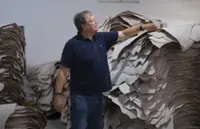Employees working at Greenlab Diamonds, a firm manufacturing lab-grown gems on the outskirts of Surat. Photo: AFP
The glittering diamonds sparkle the same but there are key differences: mined natural gems are more than a billion years old, while laboratory-made rocks are new and cost less than half the price.
Man-made gems are reshaping the US$89bil (approximately RM424bil) global diamond jewellery market, especially in the west Indian city of Surat where 90 percent of the world's diamonds are cut and polished.





